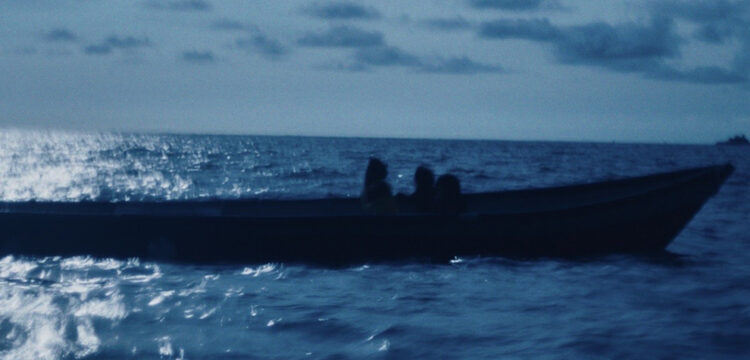Liquidity and Corporeity
On the “otras montañas, las que andan sueltas bajo el agua” at Ocean Space
The exhibition otras montañas, las que andan sueltas bajo el agua, presented at Ocean Space, initiates a process of mediating layered readings that offers the public new forms of accessibility and understanding in relation to the most shared space on the planet: the ocean. The exhibition project, along with the two new commissions by artists Nadia Huggins and Tessa Mars, reveals a potential dimension—one in constant motion and transformation.
In A Shipwreck is Not a Wreck (2025), Huggins reflects on improvisation~freestyle as both an aesthetic and political practice capable of disrupting perceptual structures codified by Western culture. The video installation immerses viewers in a post-shipwreck scenography: the wreck of a stranded vessel, inhabited by human and non-human entities, becomes the site of reciprocal transformation, where boundaries between organic and inorganic matter, subject and environment, begin to dissolve. The shipwreck, more than an event, acts as a trigger. From this point of departure, the artist constructs a critique of the linearity and progressivist rhetoric through which the life sciences and humanities often narrate origin and evolution. Improvisation~freestyle is not just a subject but a method: a performative grammar that redirects attention toward new perceptual modalities, beyond the binary logic of control and order. Through visual layering, sonic shifts, and temporal disorientation, Huggins offers a dense, almost tactile sensorial experience—one that invites the viewer to navigate the wreck not as ruin, but as a fertile zone for reorganizing life itself.
In a call to the ocean (2025), Tessa Mars invites us to traverse the mountainous landscapes above sea level—territories long intertwined with acts of cimarronaje by Indigenous and African communities across Abya Yala. These mountain formations are more than geographic features; they are living sites of resistance where entrenched colonial binaries are challenged and reimagined. Through a richly layered painted installation, Mars engages with improvisation~freestyle as a mode of creative resistance, drawing on the concept of “fugue” articulated by artist-philosopher Dénètem Touam Bona. Rather than a simple flight, fugue here signifies a dynamic escape—a relentless reshaping of reality to evade domination. For Mars, this improvisational fugue becomes a powerful tool to disrupt imposed narratives and generate new possibilities for being. Mars’s a call to the ocean offers a meditation on the wisdom embedded in mountains—both above and beneath the sea. While those above water have long fostered the creation of alternative worlds, the submerged mountains hint at futures still unfolding, urging us to reconsider the possibilities of life and transformation on a planetary scale.
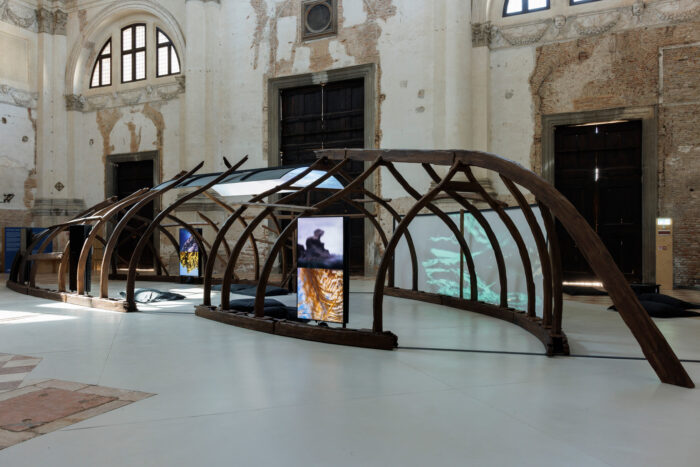
Lisa Andreani: Could you tell me more about the practice and strategy of freestyle improvisation? Can it be considered for you as a model of cultural mediation that activates other forms of approach towards the work of art and especially in a collective dimension within an institution? Can it be considered a way to bring culturally distant communities closer together?
Yina Jiménez Suriel: Improvisation~freestyle functions as both a tool and as a strategy, composed of actions uniquely configured in time and space by a subject seeking to dismantle a structure of collective subjectivation and transform it into something new, all while retaining traces of its previous state. It leaves space for identifying the need for something different while simultaneously dissolving the structures that gave rise to that need. The creation of language itself serves as a compelling example—slang, for instance, emerges as an articulation of the inadequacy of the spoken language to express the realities of a group, ultimately giving rise to a new language.
I especially appreciate the second part of your question because it gives me a chance to speak about something that rarely comes up in interviews: we are often taught to relate to improvisation with a negative connotation—as if it’s something that signals a lack of preparation, disorganization, or even unfocused. But I believe it’s quite the opposite. To improvise requires an acute sensitivity to the present, a deep listening to context, and a highly attuned creative agency. Improvisation represents a situated, embodied, and relational form of knowledge when we speak of immaterial culture—practices, expressions, and ways of being that resist homogenisation. But when applied to material structures—institutions, systems, and spaces of power—improvisation freestyle disrupts the very foundations upon which authority and control are managed. It creates the conditions for the cohabitation of difference and complexity, challenging the rigidity of dominant frameworks and opening up possibilities for more plural and inclusive modes of collective life. Again, if the institution improvises it means that it is practicing acute sensitivity to the present, a deep listening to the context, and a highly attuned creative agency… that sounds like practicing politics to me.
Yes, I do believe that freestyle improvisation can be understood as a model of cultural mediation. If we look at various forms of cultural syncretism—whether in Afro-diasporic musical traditions, in community rituals, or in urban expressions—we can see that improvisation has historically acted as a mediating force—not to smooth over difference, but to hold it, to work with its frictions and tensions. It creates the conditions for encounter and negotiation between knowledges, languages, memories, and experiences to answer to the urgencies of life itself—offering not just continuity, but the possibility to transform, and to thrive otherwise.
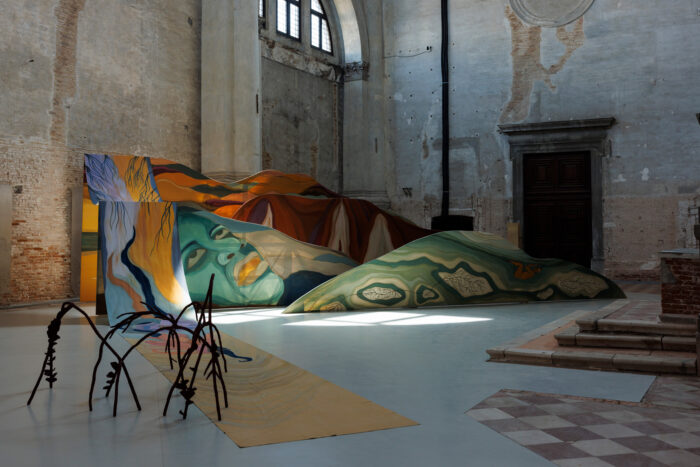
From your interdisciplinary practices emerges an exhibition that can be interpreted not only as a physical place, but as a dynamic organism capable of evolving, adapting and interacting with visitors and the surrounding environment. Allowing us a speculative approach for a moment, do you think it is possible to read the container (the institution) as an organism that breathes through the experiences and emotions of those who shape it and those who pass through it?
Yina Jiménez Suriel: In the case of Ocean Space, I don’t believe we’re in the realm of speculation—I see this as a lived reality. What enables this transformation is difficult to trace in a linear way; it’s unclear to me what came first. But I sense that Ocean Space has become a living, breathing institution precisely because its central subject is the ocean—an entity defined by constant movement, transformation, and interdependence—and because it was born out of a visceral desire for life, coupled with a deep commitment to expanding the limits of what is possible on a planetary scale.
Perhaps this is what sets Ocean Space apart from other institutions, whether in the humanities or the sciences, even those that also engage with the ocean: one of these essential components—embodied urgency or a commitment to radical imagination—is often absent.
The ocean does not allow for stillness or fixed structures. It demands fluidity, attentiveness, and a capacity for transformation. And I believe Ocean Space has absorbed these qualities in its own way of being. It moves, it listens, it evolves. I’ve been a visitor since 2022, and I’ve always had the feeling that the institution is shaped not only by those who sustain it, but also by all those who pass through it—artists, researchers, communities, and visitors… Now, as a curator of an exhibition there, I double checked that feeling… [Laughs] In that way it—being shaped not only by those who sustain it, but also by all those who pass through it—ceases to function as a neutral container and becomes something else entirely: an organism that breathes through the experiences, emotions, and urgencies it hosts.
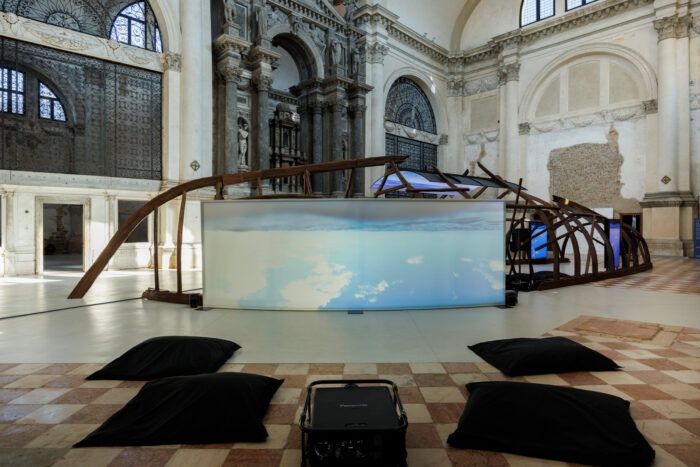
In your works, an “oblique position” emerges, a horizon that leaves out all forms of verticality in order to let itself be continually transported by the flows. Water is in fact both liquidity and corporeity. How do you think it is possible to practice a language that marks the logic of this material and at the same time is a collector of living and non-living beings?
Nadia Huggins: Often when I play with the horizon, particularly under the surface of the water, I am interested in disorienting the viewer. Challenging people’s perception of what we consider up and down or North, South, East and West. Our position in relation to landscapes is what defines borders on land. I believe that this disorientation offers a possibility to consider other ways of being. Our relationship to the Earth mostly is guided through our perceptions while we are grounded on the land. Above sea level our typical position is vertical; standing, sitting, walking, moving forward in a fixed space along a horizontal plane. In submarine environments we float horizontally–buoyancy allows us to exist on the cusp of possibility.
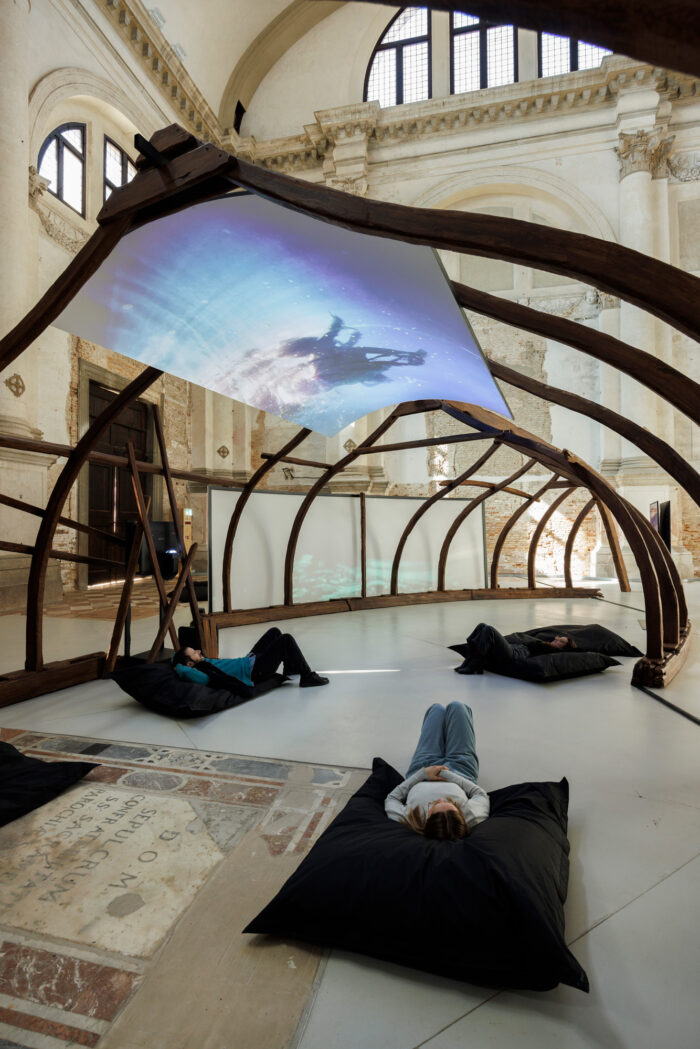
Nadia, how can we allow the ocean and waters to regenerate from a historical past that has generated binary and massive limits and structures? Is it possible to consider your work an archive of emotions but also of many different waters and their voices?
Nadia Huggins: I’m not sure if it’s completely possible to generate purely new ideas out of nothingness without having some context or relationship to a historical past–it will always exist in some way when creating. I believe it is important to expand on the context of what existed before, or in some cases it might be challenging the information presented before. Other times it can be simply filling in the gaps of knowledge that might be missing. I imagine the work that I do as responding in a very curious and visceral way to what sometimes feels like inconsequential moments, but with documentation over time it becomes apparent that what I am responding to is a changing environment. Deterioration and regeneration happen sometimes slowly and then a larger event (like a hurricane for example) can accelerate certain things. Also since I am working mostly with my breath (no dive tanks), I only use snorkeling gear, so oftentimes when I go below the surface, I am holding my breath which means I have a very limited time to capture what I consider to be the essence of the moment. This forces me to focus on particular subjects and scenarios. So yes, in some ways it is an archive of emotions—a response to what I see as value based on my lived experience of growing up in a space and seeing it change drastically over time.
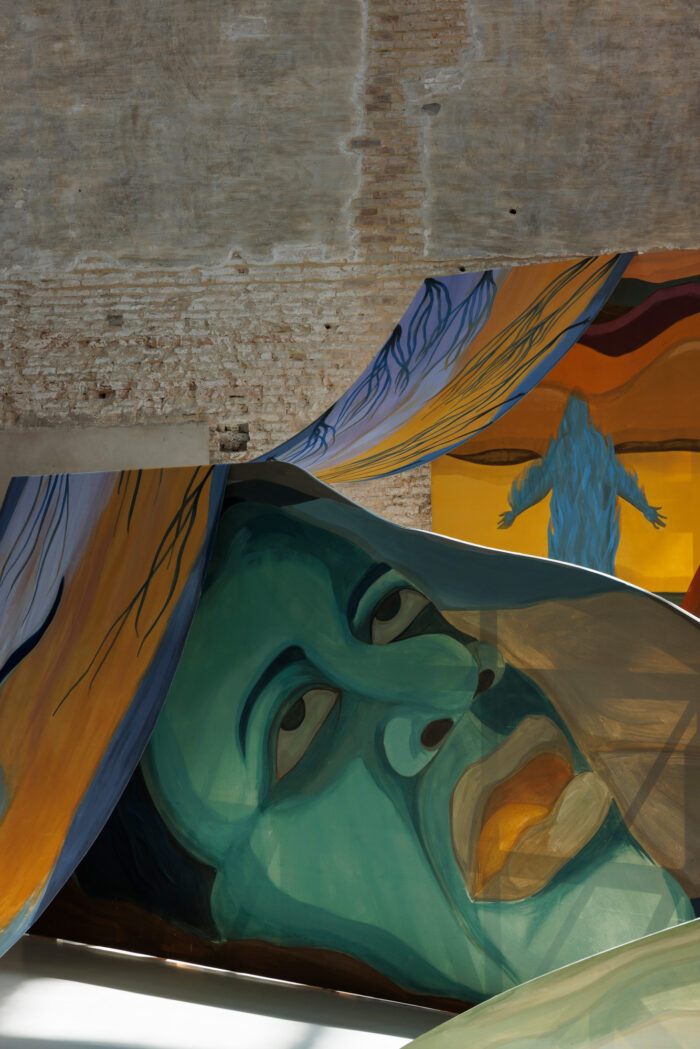
Tessa, going through your work I couldn’t help but recall a short text by Ursula K. Le Guin The Carrier Bag Theory of Fiction. Indeed, a certain independence is evident in the layered dimension of this work, a continuous process of transformation and suspension in waiting. Could we say that your “Carrier Bag” is an atmospheric space of experience and change that echoes potential new ways of living for the entire planet and its biodiversity?
Tessa Mars: My “Carrier bag” is a space of exploration and reconnection to ways of living that are different from what we’ve been taught in predominantly western spaces. The stories contained within are invitations to experience these ways and build for yourself with your community new means to relate to the planet and the various forces that inhabit it.
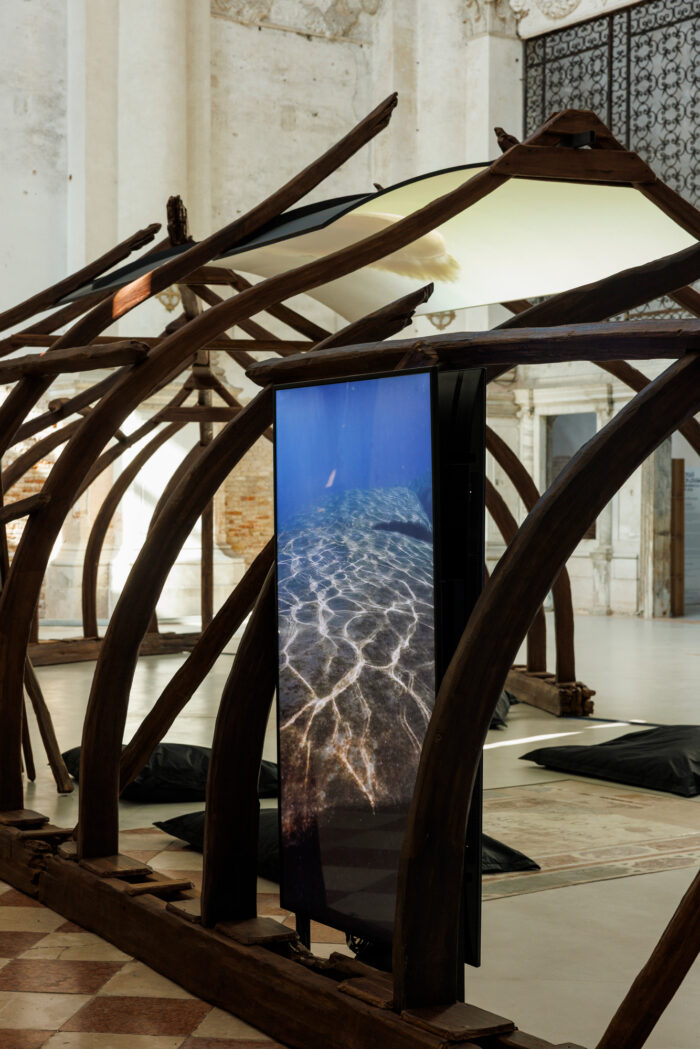
Considering art as a social driver, can we say that you, besides your works, are also exhibiting methods?
Tessa Mars: I think of my works as engaging with and following threads of possibility, what potential joy and sorrow can be found on this journey, or on that path? The methods are not clearly defined or set in stone, they are potentials that you take on and make your own.


